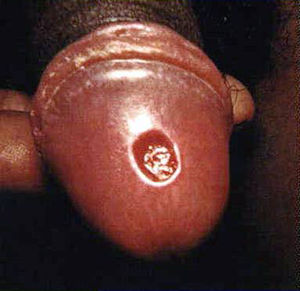THE DIAGNOSIS OF SYPHILIS: Difference between revisions
| Line 28: | Line 28: | ||
Include some current research, with at least one figure showing data.<br> | Include some current research, with at least one figure showing data.<br> | ||
<br> | <br> | ||
<br><b>Double brackets:</b> [[ | |||
<br><b>Filename:</b>Secondary stage syhilis .jpg | |||
<br><b>Thumbnail status:</b> |thumb| | |||
<br><b>Pixel size:</b>|300px| | |||
<br><b>Placement on page:</b> |right| | |||
<br><b>Legend/credit:</b> Rash on back from secondary stage syphilis [http://www.cdc.gov/ CDC]. | |||
<br><b>Closed double brackets:</b> ]] | |||
==Section 3== | ==Section 3== | ||
Include some current research, with at least one figure showing data.<br> | Include some current research, with at least one figure showing data.<br> | ||
Revision as of 00:34, 19 April 2015
Introduction

By [Heather Fantry]
At right is a sample image insertion. It works for any image uploaded anywhere to MicrobeWiki. The insertion code consists of:
Double brackets: [[
Filename: PHIL_1181_lores.jpg
Thumbnail status: |thumb|
Pixel size: |300px|
Placement on page: |right|
Legend/credit: Electron micrograph of the Ebola Zaire virus. This was the first photo ever taken of the virus, on 10/13/1976. By Dr. F.A. Murphy, now at U.C. Davis, then at the CDC.
Closed double brackets: ]]
Other examples:
Bold
Italic
Subscript: H2O
Superscript: Fe3+
Introduce the topic of your paper. What microorganisms are of interest? Habitat? Applications for medicine and/or environment?
Section 1
Include some current research, with at least one figure showing data.

Section 2
Include some current research, with at least one figure showing data.
Double brackets: [[
Filename:Secondary stage syhilis .jpg
Thumbnail status: |thumb|
Pixel size:|300px|
Placement on page: |right|
Legend/credit: Rash on back from secondary stage syphilis CDC.
Closed double brackets: ]]
Section 3
Include some current research, with at least one figure showing data.
References
[1] Hodgkin, J. and Partridge, F.A. "Caenorhabditis elegans meets microsporidia: the nematode killers from Paris." 2008. PLoS Biology 6:2634-2637.
Authored for BIOL 238 Microbiology, taught by Joan Slonczewski, 2015, Kenyon College.
